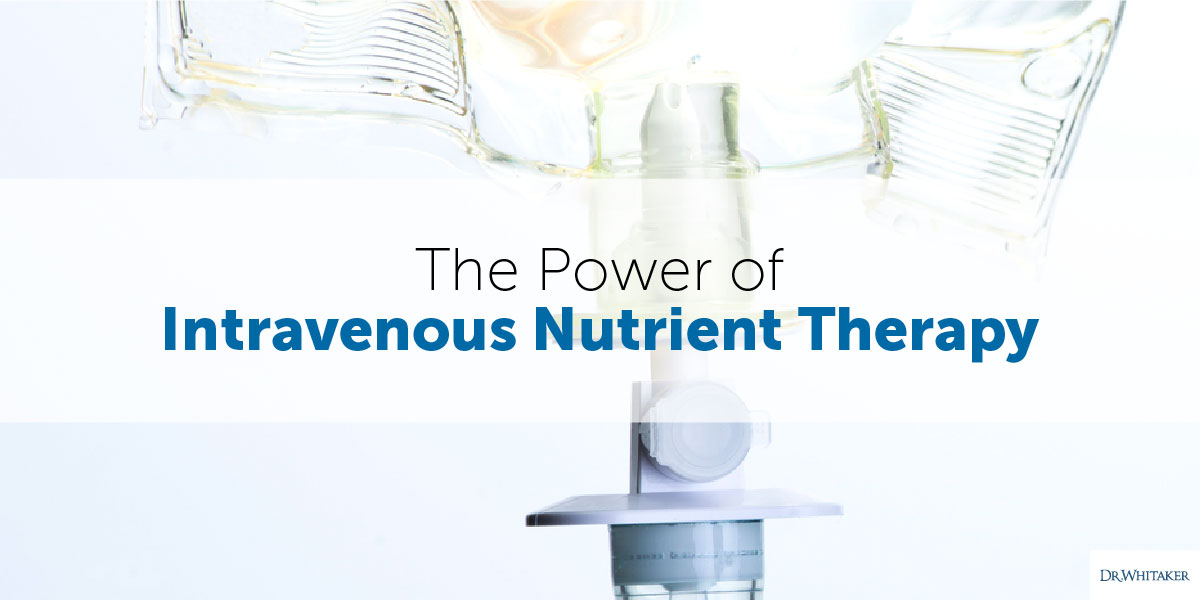 In hospital rooms around the world you’ll find patients in beds with an intravenous (IV) port—typically in their hand or arm—hooked up to a hanging bag or bottle filled with water and a dextrose or saline solution. This mixture is slowly infused into the patient’s bloodstream to help keep them hydrated.
In hospital rooms around the world you’ll find patients in beds with an intravenous (IV) port—typically in their hand or arm—hooked up to a hanging bag or bottle filled with water and a dextrose or saline solution. This mixture is slowly infused into the patient’s bloodstream to help keep them hydrated.
But these days, many people can be hooked up to something far more powerful than sugar water: intravenous nutrient therapy.
How Intravenous Nutrient Therapy Works
The beauty of intravenous nutrient therapy is that by infusing nutrients directly into the bloodstream you are able to bypass the stomach and deliver much higher doses of certain nutrients than could typically be given. For example, large oral doses of vitamin C cannot be absorbed or tolerated by the human body and are a well-known cause of loose stools. When vitamin C is infused intravenously, however, it has no effect on the gastrointestinal tract. Furthermore, IV administration promotes much higher blood levels. To put this into perspective, 10 g of IV vitamin C raises serum levels of this nutrient 25 times higher than the same dose taken orally.
Let’s take a closer look at intravenous vitamin C and two additional intravenous nutrient therapies that deserve a place in the spotlight.
Vitamin C
One of my favorite therapies of all time is intravenous vitamin C. IV vitamin C has a 70+ year track record of safe and successful clinical use and is supported by thousands of scientific studies. The list of health benefits of this powerful intravenous nutrient therapy is long and varied. They include bolstering the immune system, killing cancer cells, and fighting viruses and infectious diseases such as shingles, Lyme disease, and Epstein-Barr.
Patients who have undergone intravenous vitamin C therapy often report astounding results. Mary B. was worn down with chronic fatigue, despite having tried many different therapeutic approaches. After 10 IV vitamin C treatments, she was back to her old self. Mary P., who battled hepatitis for several years, watched her viral load drop steadily with regular infusions. Harold, who was hit hard with a particularly nasty flu virus, was completely well after two IV drips.
Magnesium
There are few minerals out there as beneficial as magnesium, and when administered as an intravenous nutrient therapy, it has a plethora of powerful health boons. For example, did you know that giving IV magnesium during a heart attack can save lives? In a double-blind, placebo-controlled clinical trial, British researchers administered IV magnesium sulfate or a saline solution to 2,000 patients within 24 hours of heart attack onset. Incredibly, the group of patients who had received magnesium had 24 percent fewer deaths than the placebo group. And one to five years later, the cardiovascular death rate was 21 percent lower in those who had been treated with magnesium.
Intravenous magnesium also has the power to smooth out irregular heart rhythms or skipped heartbeats known as arrhythmias. Chuck, a young and physically active young man, came to see us after a long and strenuous mountain bike ride in the summer heat. His heartbeat was all out of whack and it was scaring him. An EKG confirmed that Chuck was experiencing ventricular arrhythmia.
Extreme sweating and fluid loss had led to dehydration and electrolyte imbalances. I was particularly concerned about his level of magnesium, so we replenished his fluids and administered intravenous magnesium. His arrhythmia stopped immediately. After an hour of observation with no more skipped beats, we sent him home and told him to come back in a few days. When Chuck returned, his heartbeat was normal, and he was back to mountain biking again in no time. IV magnesium can also smooth out atrial fibrillation, a more common type of arrhythmia.
Another health challenge that responds beautifully to intravenous magnesium is asthma. Magnesium’s cardiovascular benefits come from its ability to relax the smooth muscles of the arteries and improve blood flow. But it also relaxes the airways and thus acts as a bronchodilator. Even after conventional treatments such as epinephrine and steroids have failed, IV magnesium can be lifesaving. I first saw Jeff as an adolescent in the throes of an asthma attack. We hooked him up to an intravenous magnesium drip and his attack was immediately alleviated. Jeff left the clinic on several nutritional supplements—among them magnesium—and his asthma eventually disappeared for good.
Glutathione
I want to close with intravenous glutathione. Glutathione is the body’s premier antioxidant, and it plays a key role in scavenging free radicals that cause oxidative damage. It’s especially powerful because in addition to mopping up free radicals, glutathione also helps other antioxidants work better. The problem is, glutathione is very poorly absorbed, and taking it orally does little to raise blood and tissue levels. That’s where intravenous glutathione comes in. Because glutathione is infused directly into the bloodstream, it bypasses the GI tract and goes to work where it’s needed.
We have been using this intravenous nutrient therapy at the clinic for 15 years now with excellent results. It is a great therapy for hard-to-treat conditions such as neurological disorders, multiple sclerosis, and chronic fatigue and is particularly effective for Parkinson’s disease.
82-year-old Joseph had suffered with Parkinson’s disease for years and had been confined to a wheelchair for seven or eight months. He was completely dependent on his wife and his grandson, who came to their house every day to help take care of him, and he couldn’t even take a drink of water without assistance. His physician started him on twice-daily infusions of glutathione, along with other therapies such as hyperbaric oxygen.
Toward the end of his first week of treatment, Joseph began to participate in activities such as dressing and eating. By the end of his second week, he was buttoning his own shirts, managing most of his self-care, and walking with a walker. (He still required assistance standing up.) At his final visit, he stood up on his own, took a few steps across the room, and kissed his wife—who looked as if she had just seen a ghost.
Where to Get Intravenous Nutrient Therapy
Even though intravenous nutrient therapies are available to doctors nationwide, many can’t—or won’t—recommend them. To find a doctor near you that might be more open minded, visit The American College for Advancement in Medicine.


